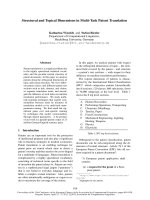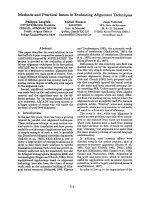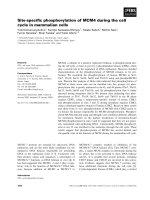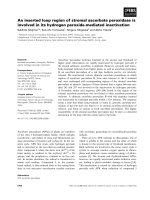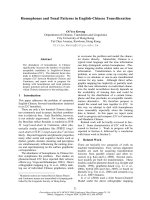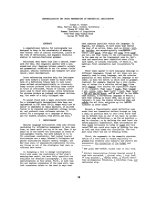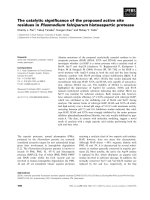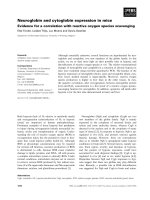Báo cáo khoa học: Functions and cellular localization of cysteine desulfurase and selenocysteine lyase in Trypanosoma brucei pot
Bạn đang xem bản rút gọn của tài liệu. Xem và tải ngay bản đầy đủ của tài liệu tại đây (396.64 KB, 11 trang )
Functions and cellular localization of cysteine desulfurase
and selenocysteine lyase in Trypanosoma brucei
Pavel Poliak
1
, Douglas Van Hoewyk
2
, Miroslav Obornı
´k
1
, Alena Zı
´kova
´
1,3
, Kenneth D. Stuart
3
,
Jan Tachezy
4
, Marinus Pilon
5
and Julius Lukes
ˇ
1
1 Biology Centre, Institute of Parasitology and Faculty of Science, University of South Bohemia, C
ˇ
eske
´
Bude
ˇ
jovice (Budweis), Czech
Republic
2 Department of Biology, Coastal Carolina University, Conway, SC, USA
3 Seattle Biomedical Research Institute, Seattle, WA, USA
4 Department of Parasitology, Charles University, Prague, Czech Republic
5 Biology Department, Colorado State University, Fort Collins, CO, USA
Introduction
Nfs-like proteins have cysteine desulfurase (CysD)
activity, and were first discovered in the nitrogen-fixing
microbe Azotobacter vinelandii, where they are dedi-
cated to the assembly of the iron–sulfur (Fe–S) clusters
of nitrogenase [1]. These pyridoxal 5-phosphate-depen-
dent proteins catalyze conversion of the amino acid
cysteine into alanine and elemental sulfur (S) [1]. All
organisms studied to date encode homologues of Nfs
(termed NifS, IscS, CsdA or SufS in bacteria, depend-
ing on the gene clusters in which they are found and
Nfs in mitochondria) that provide the S for Fe–S clus-
ters. Eukaryotic Nfs proteins have a stably interacting
partner Isd11, which is required for their function
[2–4], and transiently interact with the scaffold protein
IscU, upon which the clusters are formed [5]. Thus,
the Nfs protein has a central and conserved function
Keywords
Fe–S cluster; mitochondrion; RNAi;
selenoprotein; Trypanosoma
Correspondence
J. Lukes
ˇ
, Institute of Parasitology,
Branis
ˇ
ovska
´
31, 37005 C
ˇ
eske
´
Bude
ˇ
jovice,
Czech Republic
Fax: + 420 38 531 0388
Tel: + 420 38 777 5416
E-mail:
(Revised 22 July 2009, revised 5 November
2009, accepted 9 November 2009)
doi:10.1111/j.1742-4658.2009.07489.x
Nfs-like proteins have cysteine desulfurase (CysD) activity, which removes
sulfur (S) from cysteine, and provides S for iron–sulfur cluster assembly
and the thiolation of tRNAs. These proteins also have selenocysteine lyase
activity in vitro, and cleave selenocysteine into alanine and elemental sele-
nium (Se). It was shown previously that the Nfs-like protein called Nfs
from the parasitic protist Trypanosoma brucei is a genuine CysD. A second
Nfs-like protein is encoded in the nuclear genome of T. brucei. We called
this protein selenocysteine lyase (SCL) because phylogenetic analysis
reveals that it is monophyletic with known eukaryotic selenocysteine lyases.
The Nfs protein is located in the mitochondrion, whereas the SCL protein
seems to be present in the nucleus and cytoplasm. Unexpectedly, downre-
gulation of either Nfs or SCL protein leads to a dramatic decrease in both
CysD and selenocysteine lyase activities concurrently in the mitochondrion
and the cytosolic fractions. Because loss of Nfs causes a growth phenotype
but loss of SCL does not, we propose that Nfs can fully complement SCL,
whereas SCL can only partially replace Nfs under our growth conditions.
Structured digital abstract
l
MINT-7298305: NFS (uniprotkb:Q386Y7 ) and PHB1 (uniprotkb:Q57UX1) colocalize
(
MI:0403)bycosedimentation through density gradients (MI:0029)
l
MINT-7298357: SCL (uniprotkb:Q38DC4) and Enolase (uniprotkb:Q38BV6) colocalize
(
MI:0403)bycosedimentation through density gradients (MI:0029)
Abbreviations
CysD, cysteine desulfurase; GAP1, guide RNA-binding protein 1; HA, hemagglutinin; SCL, selenocysteine lyase.
FEBS Journal 277 (2010) 383–393 ª 2009 The Authors Journal compilation ª 2009 FEBS 383
in the assembly of Fe–S clusters [6,7]. In every pro-
karyotic and eukaryotic cell, these ancient and omni-
present cofactors are subsequently incorporated into
dozens of Fe–S proteins. These Fe–S proteins are best
known for their vital role in the redox reactions during
mitochondrial electron transport, but also have a simi-
lar function in photosynthesis [8], the formation of
biotin and thiamine, gene expression and other cellular
processes [6,7].
Moreover, many organisms contain more than one
Nfs-like protein. For example, Escherichia coli contains
three distinct Nfs-like proteins (IscS, CsdA and SufS).
Although the role of CsdA in E. coli is not fully
understood, IscS seems to have a general housekeeping
role, and SufS is thought to function during oxidative
stress [9]. The model plant Arabidopsis thaliana also
encodes three functionally distinct Nfs-like proteins
localized to the chloroplast, mitochondria and cytosol
[10]. Two Nfs-like proteins have been identified in the
apicomplexan protist Plasmodium [11], including one
localized to the apicoplast, whereas the yeast and
human genomes encode only a single Nfs-like protein.
However, the human NFS1 gene contains an alterna-
tive start site, which provides dual localization of the
protein to the mitochondria or the cytosol and nucleus
[12]. In similar fashion, the yeast Nfs1 protein is pre-
dominantly found in the mitochondion, but is also
localized to the nucleus in small amounts, and has
been shown to be indispensable for survival [13,14].
Yeast is not dependent on mitochondrial electron
transport during anaerobic growth and so it is likely
that the yeast Nfs1 protein is essential because of the
Fe–S cluster assembly for proteins localized in the
cytosol and the nucleus. Moreover, yeast Nfs1 is also
necessary for the thiolation of tRNAs [15]. Indeed,
mutation of the nuclear localization signal in the
mature Nfs1 protein is also lethal in yeast, despite hav-
ing no effect on mitochondrial Fe–S proteins. These
results suggest that the yeast Nfs1 protein has an
essential role in both nuclear and cytosolic Fe–S clus-
ter assembly [15].
Interestingly, in addition to CysD activity, all Nfs-
like proteins have selenocysteine lyase (SCL) activity,
which cleaves selenocysteine into alanine and selenium.
[16]. SCL activity is essential for organisms that
require selenium, as first documented in bacteria and
later in mammals, both of which contain selenopro-
teins [17]. Single-celled organisms, such as the green
algae Chlamydomonas reinhardtii and Emiliana huxleyi
are also known to contain selenoproteins [18],
although their set is smaller than in mammals [19].
The genome of Trypanosoma brucei, the causative
agent of African sleeping sickness, encodes two
Nfs-like proteins [20]. Downregulation of the Nfs pro-
tein, which is confined to the mitochondrion, impaired
ATP production, cellular respiration and growth, sug-
gesting that this protein is essential for the assembly of
Fe–S clusters incorporated into the mitochondrial
proteins [20]. More recently, it was discovered that in
trypanosomes ablated for Nfs, tRNA thiolation is
disrupted [21]. Moreover, in Saccharomyces cerevisiae
and T. brucei, the mitochondrially located Nfs1 and
Nfs proteins, respectively, are responsible for the thio-
lation of tRNAs in both the mitochondria and cyto-
plasm [21,22]. Because T. brucei contains a set of
selenoproteins [23–25], as well as a complete machinery
for the formation of Sec–tRNA
Sec
[26], we undertook
functional characterization of cells with downregulated
Nfs-like protein of the selenocysteine type.
Results
Phylogenetic analysis
A genome-wide search revealed that T. brucei and all
other kinetoplastid flagellates, for which full genome
sequences are available, contain two Nfs-like proteins
in their nuclear genome. Recent evidence suggests that
one of them, called Nfs (formerly TbIscS2), exhibits
CysD activity and has a function in Fe–S cluster
assembly similar to other well-studied homologues
found in eukaryotes [20]. The second gene codes for a
451 amino acid protein with calculated molecular mass
of 48.9 kDa. It contains a highly conserved PLP-bind-
ing lysine 258, the active cysteine 393 responsible for
desulfuration, as well as histidine 125, which initiates
the release of sulfur by deprotonation of l-cysteine. In
the sequence, however, the conserved serine 255 is
replaced by cysteine, and a substantial part of the
active site loop, as well as the C-terminal region
known to mediate interaction with IscU, are lacking.
A predicted nuclear localization signal (PPLKKLR) is
located in the N-terminal region of the protein
sequence.
We have performed an extensive phylogenetic anal-
ysis of Nfs-like genes from T. brucei using maximum
likelihood, maximum parsimony and neighbor joining
analyses (see Experimental procedures for details). An
unrooted phylogenetic tree obtained from an align-
ment of amino acid sequences of the Nfs ⁄ IscS and
SCL genes from 90 prokaryotes and 60 eukaryotes
revealed a very distant position for both T. brucei
genes (Fig. 1). The analysis did not recover a single
clade containing solely prokaryotic sequences, but
rather several paraphyletic clades. Eukaryotic genes
are split into two large groups of different origin,
Trypanosoma brucei selenocystein lyase P. Poliak et al.
384 FEBS Journal 277 (2010) 383–393 ª 2009 The Authors Journal compilation ª 2009 FEBS
interspersed with numerous prokaryotic Nfs-like
sequences. The early-branching group brings together
all putative eukaryotic selenocysteine lyases, which
probably represents the gene originating in the
eukaryotic nucleus. Consequently, this phylogenetic
analysis indicates that the T. brucei Nfs-like gene
encodes a selenocysteine lyase, and will be henceforth
labeled as such (SCL).
0.1
Ricinus communis
Arabidopsis thaliana
84/dt/64
Oryza sativa
90/64/61
Physcomitrella patens
Ostreococcus tauri
Ostreococcus lucimarinus
Chlamydomonas reinhardtii
Leishmania infantum
Leishmania major
Leishmania braziliensis
Trypanosoma cruzi
Rattus norvegicus
Mus musculus
Homo sapiens
Drosophila melanogaster
Caenorhabditis elegans
Dictyostelium discoideum
Cyanidioschyzon merolae
Thalassiosira pseudonana
Phaeodactylum tricornutum
Phytophthora ramorum
Saccharomyces cerevisiae
Ashbya gossypii
Candida albicans
Candida rugosa
Schizosaccharomyces pombe
Neurospora crassa
Plasmodium yoelii
Plasmodium berghei
Plasmodium falciparum
Plasmodium vivax
Theileria parva
Theileria annulata
Cryptosporidium hominis
Cryptosporidium parvum
Tritrichomonas foetus
Trichomonas vaginalis
Toxoplasma gondii
Paramecium tetraurelia
Paramecium tetraurelia
Trachipleistophora hominis
Encephalitozoon cuniculi
Rickettsia sibirica
Rickettsia felis
Rickettsia typhi
Wolbachia sp.
Ehrlichia ruminatium
Magnetospirillum magnetotacticum
Magnetococcus sp.
Leptospirillum ferrooxidans
Gloeobacter violaceus
Yersinia pestis
Entamoeba histolytica
Campylobacter jejuni
Wolinella succinogenes
Helicobacter pylori
Methanosarcina acetivorans
Methanosarcina barkeri
Methanosarcina mazei
Clostridium thermocellum
Methanosarcina barkeri
Methanosarcina acetivorans
Methanosarcina thermophila
Clostridium tetani
Ruminococcus flavefaciens
Methanospirillum hungatei
Methanosarcina mazei
Methanosarcina acetivorans
Methanosarcina barkeri
Archaeoglobus fulgidus
Archaeoglobus fulgidus
Aquifex aeolicus
Desulfitobacterium hafniense
Mus musculus
Rattus norvegicus
Homo sapiens
Gallus gallus
Tetraodon nigroviridis
Xenopus laevis
Thalassiosira pseudonana
Phaeodactylum tricornutum
Ostreococcus tauri
Ostreococcus lucimarinus
Trypanosoma cruzi
Leishmania brasiliensis
Leishmania major
Toxoplasma gondii
Symbiobacterium thermophilum
Frankia alni
Rhodococcus jostii
Leifsonia xylii
Rhodospirillum rubrum
Treponema pallidum
98/65/83
68/67/-
83/56/84
99/79/96
62/91/-
65/dt/-
58-/-
73/dt/50
95/dt/81
77/81/69
74/64/dt
52/-/dt
53/dt/-
96/74/75
66/dt/-
89/79/82
84/dt/73
61/-/52
59/dt/-
58/dt/-
90/dt/82
97/76/80
66/-/-
61/-/dt
99/87/70
84/92/95
51/-/dt
78/dt/83
69/95/78
71/100/100
87/96/95
97/90/80
70/-/51
52/-/51
61/51/63
73/68/-
Trypanosoma brucei NfS
Trypanosoma brucei SCL
Giardia lamblia
Nfs
SCL
Alpha proteobacterial Nfs
Other proteobacterial Nfs
Bacterial NifS
Nfs
Cyanobacterial Nfs
Unidentified
Bacterial and
Archaebacterial
Nfs homologues
Fig. 1. Maximum likelihood phylogenetic tree as inferred from 348 amino acid positions of the Nfs ⁄ IscS and related proteins (SUFs were
not included). Numbers above branches indicate maximum likelihood (ML) (300 replicates) ⁄ neighbor joining (NJ) (1000 replicates) ⁄ maximum
parsimony (MP) (1000 replicates) bootstrap supports. Stars indicate branches with all bootstraps overcoming 90% ‘dt’, different topology for
the particular method (maximum likelihood ⁄ neighbor joining ⁄ maximum parsimony). Sequences found in eukaryotes are given in bold.
P. Poliak et al. Trypanosoma brucei selenocystein lyase
FEBS Journal 277 (2010) 383–393 ª 2009 The Authors Journal compilation ª 2009 FEBS 385
The second well-supported group of genes contains
CysDs including Nfs of T. brucei. (Fig. 1). However,
although these Nfs genes are encoded in the eukaryotic
nucleus, they likely originate from the ancestor of the
mitochondrion, because a-proteobacteria constitute a
robust sister group. The ancestry of the Nfs gene from
the mitochondrion is thus well supported, whereas the
origin of the SCL gene remains unclear. Consequently,
these two genes have obviously acquired different, yet
overlapping, functions in the eukaryotic cell (see
below).
RNAi knockdown of SCL
An RNAi cell line was prepared by introducing into
the insect (procyclic) stage of T. brucei strain 29-13 a
pZJMb vector containing a 415 bp fragment of the
SCL gene. The criterion for the selection of this frag-
ment was the lowest possible sequence similarity to the
Nfs gene. Transfection of the procyclics resulted in sta-
ble integration and phleomycin-resistant transfectants
were obtained by limiting dilution. Induction of dou-
ble-stranded RNA synthesis upon the addition of tet-
racycline indeed resulted in efficient elimination of the
SCL mRNA in two selected clones within 24 h of
induction (Fig. 2A). In order to rule out the possibility
that cross-reactivity also induced the downregulation
of Nfs, which shares with SCL 33 and 52% identical
and similar amino acids, respectively, a northern blot
was performed with a probe against the Nfs gene,
which confirmed that the respective mRNA is not tar-
geted by nonspecific RNAi (Fig. 2B). Despite effective
silencing, growth of the cloned procyclic cells was not
inhibited upon RNAi induction with tetracycline, even
when it was followed for a prolonged period of
2 weeks (Fig. 2C).
Western blot analysis with polyclonal antibodies
generated against the T. brucei CysD Nfs and the scaf-
fold protein IscU revealed that the ablation of the
target SCL protein did not result in a detectable loss
of the above-mentioned proteins even 8 days after
RNAi induction (Fig. 3A). We also used anti-Nfs IgG
to verify the predicted mitochondrial localization of
this protein in the procyclic T. brucei. Indeed, the
protein seems to be confined to the organelle (Fig. 3B).
The purity of cellular fractions was confirmed by anti-
bodies against cytosolic enolase and mitochondrial
prohibitin (PHB1).
Localization of SCL protein
We used a tagging strategy to analyze the intracellu-
lar localization of this protein. A hemagglutinin
(HA
3
) tag was attached to the C-terminus of the full-
size SCL gene in a vector that allows inducible
expression of the tagged protein driven by a strong
procyclin promoter. The tag was placed on the C-ter-
minus in order to not interfere with a predicted
nuclear import signal usually located at the N-termi-
nus. Subcellular fractions of the transfected procyclic
cells were obtained by digitonin treatment performed,
as described elsewhere [20]. As shown by western blot
analysis of the total cell lysate and the mitochondrial
and cytosolic fractions, tagged protein is detected
only in the cytosolic fraction, which is composed of
nuclei and the cytosol (Fig. 4A). Polyclonal antibodies
against enolase and guide RNA-binding protein 1
(GAP1) were used as cytosolic and mitochondrial
loading controls, respectively.
–246
1.35 kb
mRNA
mRNA
10
15
10
14
10
13
10
12
10
11
10
10
10
8
10
7
10
6
1234567891011121314
Days after RNAi induction
Log cell·mL
–1
46
–
2
dsRNA
B
C
A
Fig. 2. Effect of SCL RNAi on mRNA levels. (A) SCL mRNA levels
were analyzed by blotting total RNA extracted from the non-
induced SCL cells ()) and SCL cells harvested 2, 4 and 6 days after
RNAi induction. The position of the targeted mRNA and the double-
stranded (ds) RNA synthesized following RNAi induction are indi-
cated with arrows. (B) Nfs mRNA levels were analyzed in the RNA
samples described in (A). As a control, both gels were stained with
ethidium bromide to visualize rRNA bands. (C) Effect of SCL RNAi
on cell growth, compared with 29-13 and noninduced cells. The
numbers of 29-13 cells (diamonds), noninduced cells (triangles) and
those induced by the addition of 1 lg ÆmL
)1
tetracycline (circles)
were plotted as the product of cell density and total dilution.
Growth curves are one representative set from three experiments.
Trypanosoma brucei selenocystein lyase P. Poliak et al.
386 FEBS Journal 277 (2010) 383–393 ª 2009 The Authors Journal compilation ª 2009 FEBS
This result was further corroborated by fluorescent
microscopy of tetracycline-induced cells bearing the
TAP-tagged SCL gene. The cells were stained by
4¢,6-diamidino-2-phenylindole and prepared for immu-
nocytochemistry using a polyclonal a-myc antibody.
Interestingly, most of the signal was observed in nuclei
with some signal also distributed throughout the cyto-
plasm, which may imply a dual localization of the
Nfs-like protein, or its presence in the cytoplasm
because of its overexpression (Fig. 4B). As a control
for staining of the mitochondria, the mAb mAb56
against the mitochondrial MRP1 ⁄ 2 complex [27] was
used (Fig. 4B). MS analysis of the TAP-tagged purified
SCL protein failed to identify any protein associated
with it, indicating that the SCL protein has no strongly
interacting partner (data not shown).
Measurement of enzymatic activities
Selenoproteins have previously been detected in the try-
panosome proteome [23–25]. Because selenoprotein syn-
thesis would require the generation of elemental Se from
selenocysteine, we analyzed SCL activity in the procyclic
cells. Moreover, because Nfs-like proteins can use cyste-
ine and selenocysteine as substrate [28], we tested
whether the elimination of SCL resulted in a decrease in
or disruption of the SCL and CysD activities. Specific
activities for the cysteine and selenocysteine substrates
were measured in the noninduced and RNAi-induced
knockdown cells for SCL characterized above, and also
in the noninduced and Nfs RNAi-induced cells
described earlier [20]. The measurements in total cell
lysates showed that specific activities for both substrates
are decreased in each of the knockdowns (data not
shown). This experiment strongly supports the hypothe-
sis that both proteins function as possible CysDs and
may also have selenocysteine lyase activity.
To determine if the SCL and CysD activities differed
in cellular compartments, cytosolic and mitochondrial
protein fractions were prepared and analyzed
A
B
Fig. 3. Effect of SCL RNAi on protein levels and cellular localization
of Nfs. (A) Nfs and IscU protein levels were analyzed by western
blot analysis in extracts from 29-13 procyclics, as well as from the
non-induced SCL cells ()) and SCL cells harvested 2, 4 and 6 days
after induction. Coomassie Brilliant Blue staining of proteins
obtained from 5 · 10
6
cellsÆlane
)1
is shown as a loading control.
(B) Nfs in localized in the mitochondrion. Western blot analysis of
total (T), cytosolic (C) and mitochondrial (M) lysates immunoprobed
with the polyclonal antibodies against Nfs, enolase and prohibitin
(PHB1). Anti-enolase and anti-prohibitin IgG were used as cytosolic
and mitochondrial markers, respectively.
A
B
ab
cd
Fig. 4. Nuclear localization of inducibly expressed HA
3
-tagged and
TAP-tagged SCL protein, respectively. (A) Immunoblot analysis of
the HA
3
-tagged protein in total cell lysates (T), and cytosolic (C) and
mitochondrial fractions (M) obtained from noninduced cells and
cells, in which expression of HA
3
-tagged SCL was induced by the
addition of tetracycline. Parental 29-13 cells were used as a control.
The a-GAP1 and a-enolase polyclonal antibodies were used as
mitochondrial and cytosolic markers, respectively. (B) Immunolocal-
ization of the TAP-tagged SCL protein in procyclic T. brucei (a) 4¢,6-
diamidino-2-phenylindole-staining of nuclear and kinetoplast DNA;
(b) mAb mAb56 against the mitochondrial MRP1 ⁄ 2 complex was
used to visualize the single mitochondrial network; (c) predomi-
nantly nuclear located TAP-tagged SCL protein was visualized by
fluorescence microscopy using polyclonal anti-c-myc serum coupled
with fluorescein isothiocyanate-conjugated secondary antibody; (d)
merged fluorescence images. Nucleus (n) is indicated with an
arrow, kinetoplast (k) with an arrowhead.
P. Poliak et al. Trypanosoma brucei selenocystein lyase
FEBS Journal 277 (2010) 383–393 ª 2009 The Authors Journal compilation ª 2009 FEBS 387
separately (Fig. 5). Wild-type SCL specific activity was
2.5-fold higher in the cytosol than in the single reticu-
lated mitochondrion. Four days after RNAi induction,
both cell lines with downregulated SCL or Nfs showed
a decrease in the SCL specific activity in the cytosol,
and to a greater extent in the mitochondrion
(Fig. 5C,D). Knockdowns for Nfs, which is the procy-
clic T. brucei confined to the mitochondrion [20], had
a lower SCL specific activity than cells in which SCL
was ablated. Measurement of the CysD activity indi-
cated an even more pronounced decrease. Again, in
wild-type cells, this specific activity was 2.5-fold
higher in the cytosol than in the mitochondrion.
Approximately 20% and 40% of the specific activity in
the cytosolic fraction was retained in the SCL and Nfs
RNAi cell lines, respectively (Fig. 5A). By contrast,
CysD specific activity was virtually eliminated from
the mitochondrion of these cell lines, with only 11%
present in the Nfs knockdowns (Fig. 5B).
In both knockdown cells, SCL and CysD activities
began to increase on day 8 after RNAi induction. This
general trend is expected because it is well known that
T. brucei can become resistant to RNAi, usually after
1 week. However, it is worth noting that the SCL
activity recovers more slowly in SCL than in Nfs
knockdowns, and the same applies to CysD activity in
the respective cells (data not shown).
Discussion
Initially, the mitochondrion was considered the sole
compartment in which Fe–S clusters are generated for
the entire eukaryotic cell [29]. Soon afterwards, the
localization of Nfs-like proteins to the nucleus and
cytosol was discovered [7,30]. Studies in plants also
revealed that an independent center of Fe–S cluster
synthesis is present in the chloroplast [31], which is not
surprising given the evolutionary history of plant plast-
ids and the requirement of an electron transport chain
in both the mitochondrial and chloroplastic compart-
ments. It is now becoming more apparent that the
assembly of Fe–S clusters is not restricted to where the
CysDs are localized. This scenario was primarily
supported by the observation that the Fe–S assembly
AB
CD
Mitochondria – SCL activity
Mitochondria – CysD activity
1
0.9
0.8
0.7
0.6
0.5
0.4
0.3
0.2
0.1
0
Cytosol – SCL activity
Cytosol – CysD activity
2
1.8
1.6
1.4
1.2
0.8
0.6
0.4
0.2
0
1
3
2.5
2
1.5
1
0.5
0
29–13
C
MT
CM T CM T
SCL
Nfs
29–13
0.9
0.8
0.7
0.6
0.5
0.4
0.3
0.2
0.1
0
CMT CMT CMT
SCL
Nfs
29–13
SCL
Nfs
29–13
SCL
Nfs
46.6 kDa
25.1 kDa
Enolase
MRP2
Fig. 5. Measurement of CysD and SCL specific activities. Mitochondrial and cytosolic protein extracts were obtained from parental 29-13
cells, and the Nfs and SCL knockdowns after 4 days of RNAi induction, as described in Experimental Procedures. The purity of all protein
fractions used for activity measurement was controlled by western blot analysis using antibodies against mitochondrial RNA-binding protein
(MRP2) and enolase, used as mitochondrial and cytosolic markers, respectively. The mean and SD values represent the averages of multiple
measurements of three independent RNAi inductions. (A) Cys desulfurase activity was measured in cytosolic fractions. Units are in nmol
sulfideÆmin
)1
Ælg protein
)1
. (B) Cys desulfurase activity was measured in mitochondrial fractions. Units are in nmol sulfideÆ min
)1
Ælg protein
)1
.
(C) SCL activity was measured in cytosolic fractions. Units are in lmol selenideÆmin
)1
Ælg protein
)1
. (D) SCL activity was measured in mito-
chondrial fractions. Units are in lmol selenideÆmin
)1
Ælg protein
)1
.
Trypanosoma brucei selenocystein lyase P. Poliak et al.
388 FEBS Journal 277 (2010) 383–393 ª 2009 The Authors Journal compilation ª 2009 FEBS
in yeast appeared to depend on a mitochondrial mem-
brane transporter [32]. An increasing amount of data
now point towards the existence of a cytosolic iron–
sulfur cluster assembly pathway termed CIA, which
may serve the synthesis of Fe–S clusters assembled
onto nuclear and cytosolic proteins [7].
As reported earlier, the downregulation of Nfs dra-
matically lowers the activities of mitochondrial Fe–S
cluster-containing enzymes, causing a significant
decrease in the growth rate of T. brucei procyclics [20].
Moreover, in trypanosomes, as well as in yeasts, this
protein was recently shown to be indispensable for the
thiolation of cytosolic and mitochondrial tRNAs
[21,22,33]. Importantly, analysis of the status of tRNA
thiolation in cells depleted for the SCL protein did not
reveal any changes demonstrating that this enzyme is
not involved in tRNA metabolism [21]. As we show in
this study, after silencing of SCL, CysD activity
decreases by 75% in both the mitochondrion and
the cytosol. Almost the same decrease is observed in
cells in which Nfs was targeted by RNAi, although in
the mitochondrion of these knockdowns CysD activity
decreases by 90% (Fig. 5). In analogy with other
eukaryotes containing selenoproteins [34], T. brucei
was supposed to be dependent upon the SCL activity
for the formation of putatively essential selenoproteins.
However, recent finding suggest that selenoproteins are
not needed for the survival of trypanosomes, at least
under cultivation conditions [26], hinting that SCL
may also be dispensable. We have confirmed this unex-
pected observation by experiments with auranofin, a
highly specific inhibitor of selenoenzymes [23], because
the downregulation of SCL did not influence the cell’s
sensitivity to the drug compared with its wild-type
counterparts (data not shown). Many selenoproteins
are involved in alleviating oxidative stress or have
redox properties, for example, the glutathione peroxid-
ases [10]. Perhaps selenoproteins in T. brucei are only
expressed after infection of their mammalian host, as a
way to survive an oxidative burst.
All Nfs-like proteins are known to contain both
CysD and SCL activities [28]. Group I Nfs-like pro-
teins (Nfs1, IscS and Nfs in this study) typically have
approximately eightfold higher activity towards selen-
ocysteine than cysteine. The preference for selenocy-
steine is much greater in Group II Nfs-like proteins
(CpNifS, SufS and SCL in this study), where the
activity can be up to 3000-fold higher towards seleno-
cysteine [16,19]. Therefore, the interchangeable activi-
ties of SCL and Nfs of T. brucei are not surprising.
It is worth noting that, whereas in the T. brucei pro-
cyclics downregulation of Nfs leads to a concomitant
decrease in its binding partner IscU (P. Changmai &
J. Lukes
ˇ
, unpublished results), the level of IscU is
not altered in cells depleted for SCL, indicating that
there is no mutual dependence between these two
proteins. Using specific antibodies against Nfs and a-
TAP antibodies for the tagged SCL, we have shown
that the former protein is confined to the mitochon-
drion, whereas the latter is, quite surprisingly, present
mostly in the nucleus and cytoplasm. Thus, we have
anticipated that upon downregulation of one of these
enzymes, the CysD and SCL activities will decrease
only in the compartment where the ablated protein
resides. However, downregulation of SCL leads to a
decrease in both activities in the cytosol and the
mitochondrion, and a similar result was found for
cells in which Nfs was targeted. Because the selected
RNAi strategy and northern analysis ruled out possi-
ble off-target RNAi silencing, another explanation
has to be put forward. It is possible that despite their
immunoreactivity in only a single compartment, both
proteins are also present at amounts undetectable
with the available antibodies in the other cellular
compartment, namely SCL in the mitochondrion and
Nfs in the cytosol. Such a dual localization is known
for Nfs1 in yeast, where the bulk of the enzyme
resides in the organelle, but a small amount is also
active in the nucleus [15]. Because there is only a
faint signal [35], human CysD was initially over-
looked in the nucleus. Recent identification of its
binding partner Isd11 in this compartment, as well as
in the mitochondrion, speaks in favor of a dual (or
even multiple) localization of numerous Fe–S cluster
assembly proteins in the eukaryotic cell [36].
Indeed, to explain the measured activities and their
downregulation in respective RNAi knockdowns of
T. brucei, such a dual localization of CysD and SCL
can be invoked. However, the amounts of both pro-
teins in the ‘other’ compartment must be very small,
because neither the polyclonal antibody against Nfs,
nor tagging of SCL allowed detection of the respective
proteins in the cytosol and mitochondrion. Alterna-
tively, indirect secondary effects may explain the
observed activity profiles. Nfs downregulation leads to
a strong pleiotropic phenotype which may in turn
result in a reduction of cytosolic SCL and CysD activi-
ties. By contrast, downregulation of SCL does not lead
to an observable phenotype and the effects on mito-
chondrial enzyme activities are not as pronounced as
the effect of Nfs ablation on cytosolic activities. The
simultaneous loss of activities in both cytosolic and
mitochondrial compartments may also be a reflection
of some kind of coordination between cytosolic and
mitochondrial Fe–S assembly machineries. RNAi-
induced knockdown of either SCL or Nfs decreases
P. Poliak et al. Trypanosoma brucei selenocystein lyase
FEBS Journal 277 (2010) 383–393 ª 2009 The Authors Journal compilation ª 2009 FEBS 389
both activities in the T. brucei procyclics. One impor-
tant difference between these RNAi cell lines is that
although knockdown of SCL shows no growth pheno-
type, downregulation of Nfs substantially slows the
growth of T. brucei, suggesting that it is the main Nfs
protein in these flagellates. However, based on the
available data, the growth phenotype of the Nfs
knockdown can be ascribed to another function of this
protein. The absence of Nfs disrupts Fe–S cluster
assembly, monitored by the decrease in the activities of
Fe–S cluster-containing proteins, such as the cytosolic
and mitochondrial aconitases [20]. At the same time, a
general decrease in tRNA thiolation affects their sta-
bility and surprisingly acts as a negative determinant
for cytosine to uridine editing of mitochondrial
tRNA
Trp
, inevitably leading to disruption of mitochon-
drial translation [21]. It thus appears that it is primar-
ily the lack of thiolation which causes the growth
phenotype of procyclic T. brucei interfered against Nfs,
because a similar decrease in CysD activity in the SCL
RNAi cells is insufficient to markedly slow their
growth. Consequently, it appears that in the absence
of one Nfs-type enzyme in a given cellular compart-
ment, the other Nfs-type protein or another as yet
unknown protein with an overlapping activity upholds
the CysD and SCL activities at a level sufficient for
survival, although at levels significantly lower than
those in the wild-type cells. This is not particularly sur-
prising in the case of mitochondrial and cytosolic SCL
activities, which remain relatively high in both knock-
downs. However, it is quite unexpected in the case of
mitochondrial CysD activity, which decreases in the
SCL knockdowns to only 15% of the wild-type
level, yet the cells are still able to retain unabated
growth.
Using MS analysis we have shown that, like in
other eukaryotes, T. brucei Nfs co-purifies with its
highly conserved binding partner Isd11 (Z Paris, P
Changmai & J Lukes
ˇ
unpublished results), although
SCL does not seem to stably interact with any other
protein (this study). However, SCL is still capable of
strong CysD activity in vitro, although the same activ-
ity of the Nfs protein in microsporidia was shown to
be strongly potentiated by bound Isd11 [4], the
knockdown of which is lethal in yeast [2,3] as well as
in trypanosomes (Z Paris, P Changmai & J Lukes
ˇ
,
unpublished results). In E. coli, deletion of one Nfs-
like protein is not lethal, which was attributed to
complementation by another Nfs-like protein, SufS.
We propose that in a similar fashion, Nfs can fully
complement SCL, however, SCL can only partially
fulfill the functions of Nfs, perhaps because it is inca-
pable of binding Isd11.
Experimental procedures
Phylogenetic analysis
Available homologues for genes encoding Nfs ⁄ IscS, NifS
and SCL from prokaryotes and eukaryotes were downloaded
from GeneBankÔ. Special attention was placed on using
genes in which the function in question had been confirmed
experimentally. Amino acid sequences of the genes were
aligned using kalign [37]; ambiguously aligned regions and
gaps were excluded from further analysis. Phylogenetic trees
were computed using maximum likelihood (phyml) [38],
maximum parsimony (paup* b4.10) [39] and neighbor join-
ing (asatura; the particular method is designed to deal with
saturation of amino acid positions) methods [40]. The model
for amino acid substitutions (WAG + I + C) was inferred
from the dataset using prottest [41]. Analogously, all
parameters for maximum likelihood analysis (likelihood of
the tree is ln = )53614.118606; gamma shape para-
meter = 1.249; proportion of invariants = 0.012) were
derived from the particular dataset. The robustness of con-
structed trees was tested by bootstrap analyses (maximum
likelihood in 300 replicates; maximum parsimony and neigh-
bor joining with 1000 replicates) and is indicated in Fig. 1.
Both T. brucei genes are highlighted.
Plasmid constructs, transfection, RNAi induction
and growth curves
The T. brucei procyclic cell lines with inducible ablation of
either Nfs or Nfs-like protein were described previously
[20,21]. Synthesis of double-stranded RNA was induced by
the addition of 1 lgÆmL
)1
tetracycline. Two clonal cell lines
(A and D), in which the Nfs-like mRNA was targeted, were
obtained by limiting dilution in plates at 27 °C in the pres-
ence of 5% CO
2
.AnHA
3
-tagged Nfs-like fusion protein
expressed from the pJH54 vector was electroporated into
the 29-13 procyclics as described elsewhere [21]. Next, mito-
chondrial and cytosolic fractions were obtained from cells
resistant to 1 lgÆmL
)1
tetracycline and used for immunode-
tection of the HA
3
-tagged protein.
Northern and western blots
Detection of Nfs-like mRNA isolated from the noninduced
cells and cells 2, 4 and 6 days of RNAi induction was carried
by northern blot analysis using a random primed labeled
probe and formaldehyde gel electrophoresis of total RNA
following standard protocols [42]. All antibodies used for
western blots were generated against T. brucei proteins over-
expressed in E. coli. Cell lysates corresponding to 5 · 10
6
procyclic cells per lane were separated on a 12% SDS ⁄ PAGE
gel and blotted. The polyclonal rabbit antibodies against
IscU, MRP2, GAP1, PHB1 and enolase were used at
1 : 1000, 1 : 1000, 1 : 1000, 1 : 1000 and 1 : 150 000, respec-
Trypanosoma brucei selenocystein lyase P. Poliak et al.
390 FEBS Journal 277 (2010) 383–393 ª 2009 The Authors Journal compilation ª 2009 FEBS
tively [43–45]. The polyclonal chicken antibodies against Nfs
were used at 1 : 500. Secondary anti-rabbit IgG (1 : 1000)
(Sevapharma, Prague, Czech Republic) coupled to horserad-
ish peroxidase were visualized using the ECL kit (Amersham
Biosciences, Uppsala, Sweden). To detect the Nfs-like pro-
tein, lysates from cells stably expressing the SCL protein
HA
3
-tagged at its C-terminus were separated and blotted as
described above, and the membranes were treated with
monoclonal anti-HA
3
-tag mouse IgG, followed by chicken
anti-mouse IgG coupled to horseradish peroxidase. Western
blot bands were quantified with the software luminescent
image analzyer las-3000, Image Reader LAS-3000.
TAP-tag analysis
The whole Nfs-like gene was PCR amplified and cloned
into pLew79–MHT vector which contains c-myc, His, cal-
modulin-binding peptide and protein A tags in that order.
The last two tags are separated by a TEV protease cleavage
site [46]. Upon linearization by NotI, the resulting construct
was transfected into the T. brucei 29-13 procyclic strain.
Nfs-like TAP cells, checked for inducible and tightly regu-
lated expression, were induced for 48 h by the addition of
1 lgÆmL
)1
of tetracycline to the medium. TAP purification
was performed as described elsewhere [43].
Digitonin fractionation and subcellular
localization
Purification of mitochondrial vesicles isolated by digitonin
fractionation from 5 · 10
8
cells was performed as described
elsewhere [21]. Pelleted mitochondrial vesicles were stored at
)80 °C until further use. Subcellular localization of the
expressed tagged protein within the cell was determined by
immunofluorescence assay using polyclonal anti-Myc IgG
(Invitrogen, Carlsbad, CA, USA). Briefly the cells were fixed
with 4% formaldehyde, permeabilized with 0.2% Tri-
ton X-100, blocked with 5% fetal bovine serum, and incu-
bated with anti-Myc IgG at a 1 : 100 dilution. After
washing, the cells were incubated with anti-rabbit fluores-
cein isothiocyanate-conjugated IgG (1 : 250 dilution)
(Sigma, Steinheim, Germany), washed, and treated with
4¢,6-diamidino-2-phenylindole stain to visualize DNA. Co-
localization analysis was performed using mAb56 against
the mitochondrial MRP1 ⁄ MRP2 complex [27] coupled with
Texas Red-X conjugated secondary antibody (Invitrogen).
Phase-contrast images of the cells and their fluorescence
were captured with a Nikon fluorescence microscope
equipped with a camera and appropriate filters.
Enzyme essays
Cysteine desulfurase activity was assayed at 25 °C, essen-
tially as described previously [47]. Briefly, protein extract
was added to a reaction mixture containing 25 mm
Tris ⁄ HCl, pH 7.4, 100 mm NaCl, 10 lm pyridoxal 5¢-phos-
phate, 1 mm dithiothreitol and 500 lm cysteine. The
reaction was stopped by the addition of 20 lLof20mm
N,N-dimethyl-p-phenylenediamine in 7.2 m HCl. Methylene
blue was formed by the addition of 20 lLof30mm FeCl
3
in 1.2 m HCl and was assayed by measuring the absorbance
at 670 nm. The selenocysteine lyase activity was measured
as described elsewhere [31]. In short, a 100 lL reaction mix-
ture of 0.12 m tricine, 10 mm selenocysteine, 50 mm dith-
iothreitol and 0.2 mm pyridoxal phosphate was allowed to
incubate for 30 min, before being stopped with lead acetate.
The formation of lead–selenide was quantified at 400 nm.
Acknowledgements
We thank Ondr
ˇ
ej S
ˇ
mı
´
d (Charles University, Prague)
and Milan Jirku˚ (Biology Centre, C
ˇ
eske
´
Bude
ˇ
jovice)
for their valuable contributions at an early stage of
this project. We also thank Aswini Panigrahi (Seattle
Biomedical Research Institute, Seattle) for help with
the TAP tag study. This work was supported by the
Grant Agency of the Czech Republic 204 ⁄ 09 ⁄ 1667, the
Ministry of Education of the Czech Republic
(LC07032 and 2B06129 and 6007665801) and the Prae-
mium Academiae award to JL and by National Insti-
tutes of Health (AI065935) to KDS.
References
1 Zheng L, White RH, Cash VL & Dean DR (1994) Mech-
anism for the desulfurization of l-cysteine catalyzed by
the nifS gene product. Biochemistry 33, 4714–4720.
2 Adam AC, Bornho
¨
vd C, Prokisch H, Neupert W &
Hell K (2006) The Nfs1 interacting protein Isd11 has an
essential role in Fe ⁄ S cluster biogenesis in mitochon-
dria. EMBO J 25, 174–183.
3 Wiedemann N, Urzica E, Guiard B, Mu
¨
ller H, Lohaus
C, Meyer HE, Ryan MT, Meisinger C, Mu
¨
hlenhoff U,
Lill R et al. (2006) Essential role of Isd11 in mitochon-
drial iron–sulfur cluster synthesis on Isu scaffold pro-
teins. EMBO J 25, 184–195.
4 Goldberg AV, Molik S, Tsaousis AD, Neumann K,
Kuhnke G, Delbac F, Vivares CP, Hirt RP, Lill R &
Embley TM (2008) Localization and functionality of
microsporidian iron–sulfur cluster assembly proteins.
Nature 452, 624–628.
5 Gerber J, Mu
¨
hlenhoff U & Lill R (2003) An interaction
between frataxin and Isu1 ⁄ Nfs1 that is crucial for Fe ⁄ S
cluster synthesis on Isu1. EMBO Rep 4, 906–911.
6 Johnson DC, Dean DR, Smith AD & Johnson MK
(2005) Structure, function and formation of biological
iron–sulfur clusters. Annu Rev Biochem 74, 247–281.
P. Poliak et al. Trypanosoma brucei selenocystein lyase
FEBS Journal 277 (2010) 383–393 ª 2009 The Authors Journal compilation ª 2009 FEBS 391
7 Lill R & Mu
¨
hlenhoff U (2008) Maturation of iron–sul-
fur proteins in eukaryotes: mechanisms, connected pro-
cesses, and diseases. Annu Rev Biochem 77, 669–700.
8 Van Hoewyk D, Abdel-Ghany SE, Cohu CM, Herbert
SK, Pilon-Smith EAH & Pilon M (2007) Chloroplast
iron–sulfur cluster protein maturation requires the
essential cysteine desulfurase cpNifS. Proc Natl Acad
Sci USA 104, 5686–5691.
9 Loiseau L, Ollagnier-de-Choudens S, Nachin L, Fonte-
cave M & Nadras F (2003) Biogenesis of Fe–S cluster
by the bacterial Suf system, SufS and SufE form a new
type of cysteine desulfurase. J Biol Chem 278, 38352–
38359.
10 Van Hoewyk D, Pilon M & Pilon-Smits EAH (2008)
The function of NifS-like proteins in plant sulfur and
selenium metabolism. Plant Sci 174, 117–123.
11 Ellis KES, Clough B, Saldanha JW & Wilson RJM
(2001) NifS and SufS in malaria. Mol Microbiol 41,
973–981.
12 Land T & Rouault TA (1998) Targeting of a human
iron–sulfur cluster assembly enzyme, nifs, to different
subcellular compartments is regulated through alterna-
tive AUG utilization. Mol Cell 2, 807–815.
13 Mu
¨
hlenhoff U, Balk J, Richhardt N, Kaiser JT, Sipos
K, Kispal G & Lill R (2004) Functional characteriza-
tion of the eukaryotic cysteine desulfurase Nfs1p from
Saccharomyces cerevisiae. J Biol Chem 279, 36906–
36915.
14 Nakai Y, Umeda N, Suzuki T, Nakai M, Hayashi H,
Watanabe K & Kagamiyama H (2004) Yeast Nfs1p is
involved in thio-modification of both mitochondrial and
cytoplasmic tRNAs. J Biol Chem 279, 12363–12368.
15 Nakai Y, Nakai H, Hayashi H & Kagamiyama H
(2001) Nuclear localization of yeast Nfs1p is required
for cell survival. J Biol Chem 276, 8314–8320.
16 Mihara H, Kurihara T, Yoshimura T, Soda K & Esaki
N (1997) Cysteine sulfinate desulfinase, a NIFS-like
protein in E. coli with selenocysteine lyase and cysteine
desulfurase activities, gene cloning, purification, and
characterization of a novel pyridoxal enzyme. J Biol
Chem 272, 22417–22424.
17 Lu J & Holmgren A (2009) Selenoproteins. J Biol Chem
284, 723–727.
18 Novoselov SV, Rao M, Onoshko NV, Shi H, Kryukov
GV, Xiang Y, Weeks DP, Hatfield DL & Gladyshev
VN (2002) Selenoproteins and selenocysteine insertion
system in the model plant cell system, Chlamydo-
monas reinhardtii. EMBO J 21, 3681–3693.
19 Kryukov GV, Castellano S, Novoselov SV, Lobanov
AV, Zehtab O, Gigo R & Gladyshev VN (2003) Char-
acterization of mammalian selenoproteomes. Science
300, 1439–1443.
20 Smid O, Hora
´
kova
´
E, Vilı
´
mova
´
V, Hrdy´ I, Cammack
R, Horva
´
th A, Lukes
ˇ
J & Tachezy J (2006) Knock-
downs of mitochondrial iron–sulfur cluster assembly
proteins IscS and IscU down-regulate the active mito-
chondrion of procyclic Trypanosoma brucei. J Biol
Chem 281, 28679–28686.
21 Wohlgamuth-Benedum JM, Rubio MAT, Paris Z, Long
S, Poliak P, Lukes
ˇ
J & Alfonzo JD (2009) Thiolation
controls cytoplasmic tRNA stability and acts as a nega-
tive determinant for tRNA editing in mitochondria.
J Biol Chem 284, 23947–23953.
22 Nakai Y, Nakai M, Lill R, Suzuki T & Hayashi H
(2007) Thio modification of yeast cytosolic tRNA is an
iron–sulfur protein-dependent pathway. Mol Cell Biol
27, 2841–2847.
23 Lobanov AV, Gromer S, Salinas G & Gladyshev VN
(2006) Selenium metabolism in Trypanosoma, character-
ization of selenoproteomes and identification of a Kine-
toplastida-specific selenoprotein. Nucleic Acids Res 34 ,
4012–4024.
24 Cassago A, Rodrigues EM, Prieto EL, Gaston KW,
Alfonzo JD, Iribar MP, Berry MJ, Cruz AK & Thie-
mann OH (2006) Identification of Leishmania seleno-
proteins and SECIS elements. Mol Biochem Parasitol
149, 128–134.
25 Sculaccio SA, Rodrigues EM, Cordeiro AT, Magalhaes
A, Braga AL, Alberto EE & Thiemann OH (2008) Sel-
enocysteine incorporation in kinetoplastid, selenophos-
phate synthetase (SELD) from Leishmania major and
Trypanosoma brucei. Mol Biochem Parasitol 162, 165–
171.
26 Aeby E, Palioura S, Pusnik M, Marazzi J, Liebermann
A, Ullu E, So
¨
ll D & Schneider A (2009) The canonical
pathway for selenocysteine insertion is dispensable in
trypanosomes. Proc Natl Acad Sci USA 106, 5088–
5092.
27 Panigrahi AK, Zı
´
kova
´
A, Dalley RA, Acestor N, Ogata
Y, Anupama A, Myler PJ & Stuart KD (2008) Mito-
chondrial complexes in Trypanosoma brucei, a novel
complex and a unique oxidoreductase complex. Mol
Cell Proteomics 7, 534–545.
28 Mihara H & Esaki N (2002) Bacterial cysteine desulfu-
rases, their function and mechanisms. Appl Microbiol
Biotechnol 60, 12–23.
29 Lill R & Kispal G (2000) Maturation of cellular Fe–S
proteins, an essential function of mitochondrion. Trends
Biochem Sci 25, 352–356.
30 Rouault TA & Tong WH (2005) Iron–sulfur cluster bio-
genesis and mitochondrial iron homeostasis. Nat Rev
Mol Cell Biol 6, 345–351.
31 Pilon-Smits EAH, Garifullina GF, Abdel-Ghany S,
Kato S-I, Mihara H, Hale KL, Burkhead JL, Esaki N,
Kurihara T & Pilon M (2002) Characterization of a
NifS-like chloroplast protein from Arabidopsis: implica-
tions for its role in sulfur and selenium metabolism.
Plant Physiol 130, 1309–1318.
32 Kispal G, Csere P, Prohl C & Lill R (1999) The mito-
chondrial proteins Atm1p and Nfs1p are required for
Trypanosoma brucei selenocystein lyase P. Poliak et al.
392 FEBS Journal 277 (2010) 383–393 ª 2009 The Authors Journal compilation ª 2009 FEBS
biogenesis of cytosolic Fe ⁄ S proteins. EMBO J 18,
3981–3989.
33 Paris Z, Rubio MAT, Lukes
ˇ
J & Alfonzo JD (2009)
Mitochondrial tRNA import in Trypanosoma brucei is
independent of thiolation and the Rieske protein. RNA
15, 1398–1406.
34 Lacourciere GM, Mihara H, Kurihara T, Saki N &
Stadtman TC (2000) Escherichia coli NifS-like protein
provide selenium in the pathway for the biosynthesis of
selenophosphate. J Biol Chem 275, 23769–23773.
35 Biederbick A, Stehling O, Rosser R, Niggemeyer B,
Nakai Y, Elsasser HP & Lill R (2006) Role of human
mitochondrial Nfs1 in cytosolic iron–sulfur protein bio-
genesis and iron regulation. Mol Cell Biol 26, 5675–
5687.
36 Shi Y, Ghosh M, Tong W-H & Rouault TA (2009)
Human ISD11 is essential for both iron–sulfur cluster
assembly and maintenance of normal cellular iron
homeostasis. Hum Mol Genet 18, 3014–3025.
37 Lassmann T & Sonnhammer EL (2006) Kalign, Kali-
gnvu and Mumsa, web servers for multiple sequence
alignment. Nucleic Acids Res 34, W596–W599.
38 Guinein S & Gascuel O (2003) A simple, fast and accu-
rate algorithm to estimate large phylogenies by maxi-
mum likelihood. Syst Biol 52, 696–704.
39 Swofford DL (2000) PAUP* Phylogenetic Analysis
Using Parsimony (*And Other Methods) ver 4b10.
Sinauer Associates, Sunderland, MA.
40 Van de Peer Y, Frickey T, Taylor JS & Meyer A (2002)
Dealing with saturation at the aminoacid level, a case
study based on anciently duplicated zebrafish genes.
Gene 295, 205–211.
41 Abascal F, Zardoya R & Posada D (2005) ProtTest,
selection of best-fit model of protein evolution. Bioinfor-
matics 21, 2104–2105.
42 Vondrus
ˇ
kova
´
E, van den Burg J, Zı
´
kova
´
A, Ernst NL,
Stuart K, Benne R & Lukes
ˇ
J (2005) RNA interference
analyses suggest a transcript-specific regulatory role for
MRP1 and MRP2 in RNA editing and other RNA pro-
cessing in Trypanosoma brucei. J Biol Chem 280, 2429–
2438.
43 Zı
´
kova
´
A, Kopec
ˇ
na
´
J, Schumacher MA, Stuart KD,
Trantı
´
rek L & Lukes
ˇ
J (2008) Structure and function of
the native and recombinant mitochondrial
MRP1 ⁄ MRP2 complex from Trypanosoma brucei.
Int J Parasitol 38, 901–912.
44 Hashimi H, C
ˇ
ic
ˇ
ova
´
Z, Novotna
´
L, Wen Y-Z & Lukes
ˇ
J
(2009) Kinetoplastid guide RNA biogenesis is depen-
dent on subunits of the mitochondrial RNA binding
complex 1 and mitochondrial RNA polymerase. RNA
15, 588–599.
45 Ty´ c
ˇ
J, Faktorova
´
D, Kriegova
´
E, Jirku˚ M, Va
´
vrova
´
Z,
Maslov DA & Lukes
ˇ
J (2009) Probing for primary
functions of prohibitin in Trypanosoma brucei.
Int J Parasitol, doi:10.1016/j.ijpara.2009.07.008.
46 Jensen BC, Kifer CT, Brekken DL, Randall AC, Wang
Q, Drees BL & Parsons M (2007) Characterization of
protein kinase CK2 from Trypanosoma brucei. Mol Bio-
chem Parasitol 151, 28–40.
47 Outten FW, Wood MJ, Munoz FM & Storz G (2003)
The SufE protein and the SufBCD complex enhance
SufS cysteine desulfurase activity as part of a sulfur
transfer pathway for Fe–S cluster assembly in Escheri-
chia coli. J Biol Chem 278, 45713–45719.
P. Poliak et al. Trypanosoma brucei selenocystein lyase
FEBS Journal 277 (2010) 383–393 ª 2009 The Authors Journal compilation ª 2009 FEBS 393
